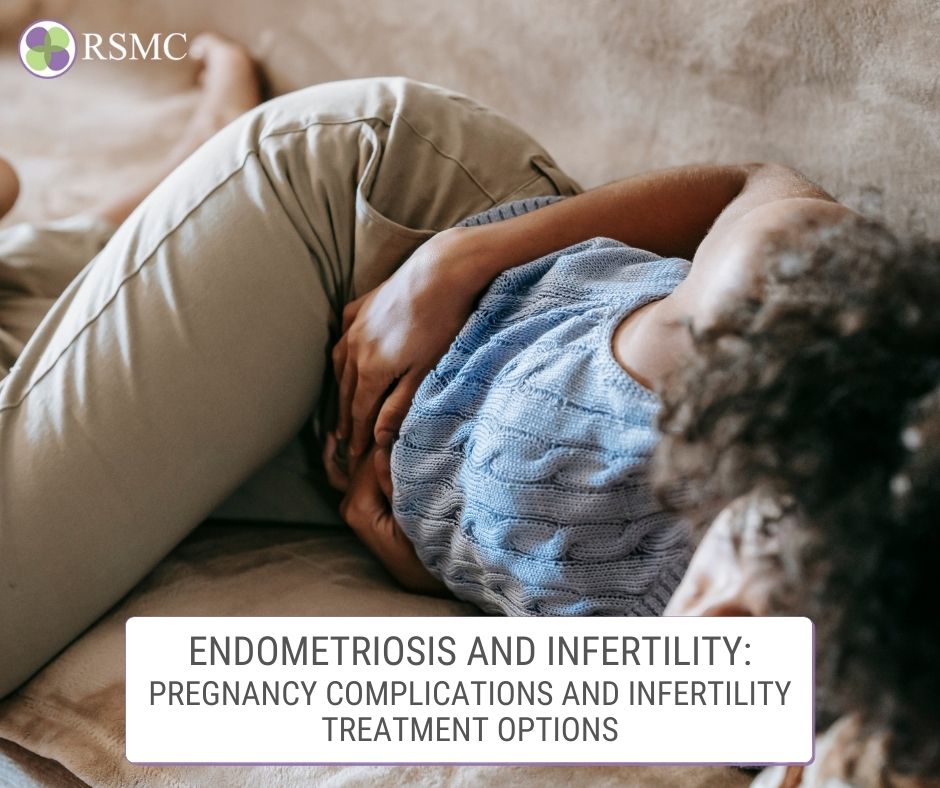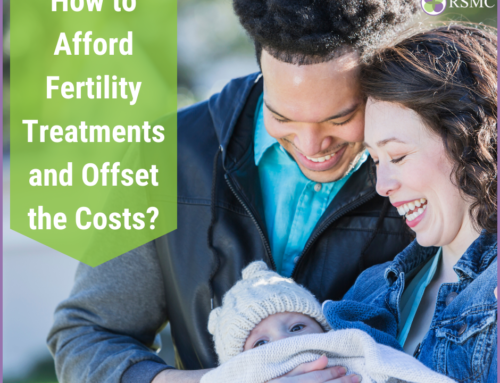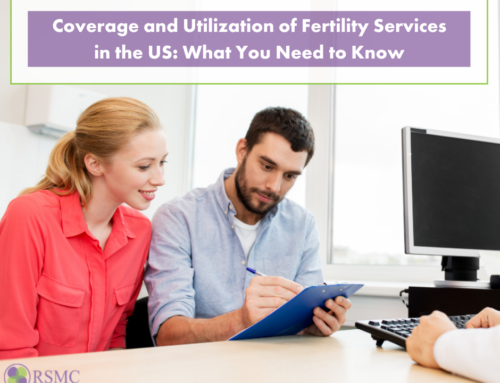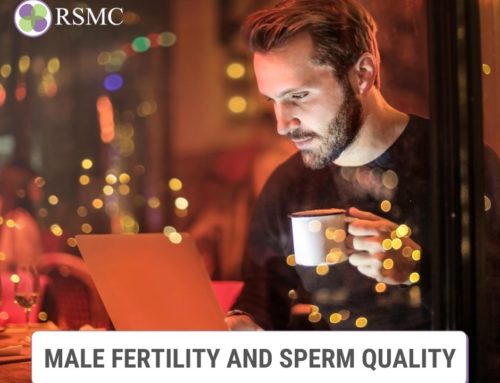One of the most common signs of endometriosis is difficulty getting pregnant. More than 30% of women living with endometriosis also suffer from infertility for reasons not well known. Plus, endometriosis has been linked with a low live birth rate and over 5.5 million women in the US show symptoms of this condition.
The good news is – there are medical treatments that can help you defeat infertility, and pregnancy on its own can help alleviate some symptoms of endometriosis.
What is endometriosis?
Endometriosis is a condition in which tissue similar to the womb’s lining (endometrium) grows in other places aside from the uterus.
It occurs when the tissue lining the uterus grows on the ovaries, bowel, fallopian tubes, and other pelvic organs. Although it is uncommon for endometrial tissue to extend beyond the pelvic region, there is a possibility. Endometrial tissue growing outside the womb is referred to as an endometrial implant.
Women dealing with endometriosis may develop several ovulatory and endocrine disorders, such as impaired folliculogenesis, luteinized unruptured follicle syndrome (LUF), luteal phase defect, and multiple or premature surges in luteinizing hormone (LH).
The hormonal changes that occur during your menstrual cycle can make the misplaced endometrial tissue to be irritated, inflamed, and painful. This implies that the tissue will grow, thicken, and eventually break down. With time, the tissue that has broken down may get trapped in the pelvis since there is nowhere for it to go. The trapped tissue in the pelvis can result in:
- Severe pain during your menses
- Irritation
- Adhesions (in which scar tissue binds the pelvic organs together)
- Scar formation
- Fertility issues
Endometriosis is a fairly common disorder that affects about 10% of women. So, you are not the only one dealing with this condition.
Who is at risk of endometriosis?
Endometriosis is more common in women who:
- Are in their forties and fifties
- Have never had a baby
- Have periods longer than 7 days
- Began their menses before age 12
- Have menstrual cycles less than 28 days
- Have a sister or mother who had endometriosis
Endometriosis signs and symptoms
The symptoms of endometriosis can vary between individuals. While some women have mild symptoms, others may experience moderate-to-severe symptoms. However, note that the severity of the pain does not in any way indicate the stage or the degree of the condition. You may experience excruciating pain yet have a mild form of endometriosis. It is also possible to have slight discomfort while suffering from a severe form of the condition.
The most common symptom of endometriosis is pelvic pain. You may also develop some of the symptoms below:
- Painful menstruations
- Bleeding between periods or heavy menstrual bleeding
- Painful periods
- Cramps one or two weeks around menstruation
- Pain after sexual intercourse
- Pain in the pelvic region before and during menstruation
- Infertility
- Lower back pain that can happen at any time during your menstrual cycle
However, you may not even have any symptoms. So, it is crucial to undergo regular gynecological examinations, which will enable your doctor to check for any changes. This is especially important if you experience two or more symptoms.
Endometriosis complications
Fertility issues are one of the more severe complications of endometriosis. Women with mild forms of the condition may be able to get pregnant and give birth to a healthy baby. However, around 30 to 40% of women living with endometriosis find it difficult to conceive.
Women with endometriosis also have higher rates of:
- Preeclampsia
- Premature delivery
- Placenta complications
- C-section deliveries
The great news is that there are many women with endometriosis who got pregnant and eventually gave birth to a healthy baby.
If you have been diagnosed with endometriosis and would like to become a parent, you may want to consider getting pregnant without further delay. Your symptoms can get worse with time, making it hard to conceive on your own. Your doctor will need to assess you before and during your pregnancy. So, consult your doctor to know the available options for you.
Even if you are not bothered about fertility, the pain from endometriosis can be difficult to manage.
Moreover, anxiety, depression, and other mental problems are also common. Speak with your doctor about ways to handle these side effects. You may also consider joining an online/offline support group for advice and encouragement needed at this time.
Cancer
Ovarian cancer is more common than expected in women with endometriosis. However, a woman’s risk of having ovarian cancer in her lifetime is pretty low. Although some studies indicate that endometriosis raises that risk, it is still very low compared to other types of cancer. However, a rare form of cancer — endometriosis-associated adenocarcinoma — can occur later in women who have had endometriosis.
Endometriosis and Infertility Issues
The major complication caused by endometriosis is impaired fertility. Nearly 1/3rd or half of women with this condition have trouble becoming pregnant.
Although no one knows for sure how endometriosis can lead to infertility, below are some possible reasons:
- Patches of endometriosis clog or alter the anatomy of the pelvic and female reproductive organs. This can make it more difficult for sperm to get to the egg.
- The immune system, which normally helps fight against diseases, attacks the developing embryo.
- The endometrium (layer of the womb lining where implantation occurs) doesn’t develop as expected.
How does endometriosis cause infertility?
Although the exact etiology of endometriosis is not known, there are many reasons that can be provided to link the condition to infertility cases.
The first reason has to do with the unfriendly molecules (cytokines) created due to the inflammation of endometriosis. Cytokines can paralyze the egg and the sperm and stop fertilization from taking place.
Another reason is that endometriosis affects the pelvic anatomy. The inflammatory process alters the fine texture of the peritoneum (membrane lining the abdominal cavity). This leads to adhesions and scarring, which makes the ovaries and uterine tubes to be blocked, preventing the sperm and egg from coming together.
Moreover, the ovaries may not ovulate, causing eggs to be trapped in the ovaries. For conception to occur, an egg needs to be released by ovaries, pass through the fallopian tube, get fertilized with sperm, and implant in the uterine wall to start development.
Endometriosis may block the uterine tube and prevent the sperm and egg from coming in contact with each other. This blockage of the female reproductive system can hinder pregnancy or result in complicated pregnancies, including miscarriages.
Studies have indicated that the amount of endometriosis seen during a diagnostic laparoscopy is associated with future fertility.
Here is a staging system for evaluating endometriosis:
- Stage 1 endometriosis (minimal disease): There are only a few tiny implants (specs) of endometriosis, and no scar tissue is seen.
- Stage 2 endometriosis (mild disease): More implants of endometriosis are seen, but a little part of the abdomen is involved. Plus, there is no scar tissue.
- Stage 3 endometriosis (moderate disease): In this case, there are many implants of endometriosis in the abdomen, which can be deep and create cavities containing endometriotic fluid. Scar tissue may also be found around the fallopian tubes or ovaries.
- Stage IV endometriosis: Many endometriotic implants, huge cysts in the ovaries, scar tissue between the womb and the rectum (the most distal segment of the large intestine), and around the fallopian tubes or ovaries.
Can I conceive if I have endometriosis?
Definitely. A lot of women who have endometriosis become pregnant. However, you may find it more difficult to conceive. Researchers believe that up to 50% of women dealing with infertility may have endometriosis.
A surgical operation known as laparoscopy can increase the pregnancy rate of women with moderate to severe endometriosis. IVF is an excellent option to consider if infertility persists.
Consult your doctor if you have endometriosis and are finding it difficult to conceive so he or she can suggest treatments, including surgery to get rid of the endometrial growths.
Treatment options for endometriosis-linked infertility
Medications don’t boost fertility. However, a lot of women have been able to get pregnant after having their endometrial tissue removed through surgery. If surgery does not work for you, you may want to pursue fertility treatments, such as IVF to raise your odds of becoming a parent while struggling with endometriosis.
Surgical treatment of endometriosis and fertility issues
Women with mild endometriosis (Stage I and II) may get pregnant naturally. However, studies have shown that if laparoscopy is performed in women struggling to conceive, they are at a higher risk of having endometriosis compared to women who experience no difficulty getting pregnant.
There is evidence that surgery may improve the pregnancy rates in the case of stage I or II endometriosis, but some data indicate that it does not help.
Generally, when women are still young (below 35), it may be reasonable to surgically remove endometriosis to check whether pregnancy will take place. However, for older women (above 35) with endometriosis, other fertility treatments are advised instead of laparoscopy.
In the case of stage III or IV endometriosis, pregnancy rates are higher following surgical removal of scar tissue or huge endometriotic cysts. If pregnancy doesn’t happen within six months of the surgery, other fertility treatments should be considered.
Sadly, a lot of women with this condition can have endometriotic cysts that return after removal. Removing cysts over and over again can lead to a loss of eggs from the ovaries, making it more difficult to conceive.
Medical treatment of endometriosis-linked infertility
A comprehensive fertility evaluation needs to be done before commencing any fertility treatment. This may include blood and hormone testing and evaluating the male partner’s sperm count. The right medical treatments depend on the stage of the patient’s endometriosis:
Stage I-II Endometriosis: Clomephene – IUI
A fertility medication known as clomiphene citrate is taken for five days after menstruation begins to improve the chances of pregnancy. The sperm sample of the male partner is washed and prepared in the fertility lab. The intended mother will then visit the clinic when she is ovulating for the sperm to be inserted into her womb using a small tube. This is carried out during a speculum examination and feels just like a Pap test. Women who are less than 40 years old have approximately a 10% chance of having a baby with a single treatment of clomiphene/IUI.
If the treatment fails to produce the desired result after 3 months or thereabout, the next options to consider are: (i) the use of injectable infertility medications with IUI or (ii) IVF (in vitro fertilization).
Stage III-IV Endometriosis
If the woman does not conceive with 6-12 months of surgical removal of moderate-severe endometriosis, IVF is often advised. In some cases, the uterine tubes are found to be blocked, and the scar tissue may be severe. At times, your doctor may suggest proceeding straight to fertility treatment with IVF.
In-Vitro Fertilization (IVF)
Before you begin this fertility treatment, your physician will let you know your chances of having a successful IVF, depending on your age and hormone testing.
Women undergoing IVF are required to take injections of fertility medications to encourage many eggs to grow and mature within the fluid-filled cavities in the ovaries known as follicles. These follicles are monitored using blood tests and ultrasounds. When the follicles grow to a specific size, the eggs are harvested from the ovaries. This is typically done under mild sleeping medication (anesthesia). A tiny, ultrasound-guided needle is used to remove the grown eggs from the ovaries through the vagina.
The process takes around 10 minutes.
The collected eggs are put inside Petri dishes and “combined” with sperm in the IVF laboratory. Most of these eggs will become fertilized and develop into embryos.
A couple of days after the egg retrieval, the woman will revisit the fertility clinic, and one of the healthy embryos will be inserted into her womb using a small tube through the cervix during a speculum examination. This procedure feels just like a Pap test, and the chances of becoming pregnant with one cycle of IVF is around 50% or higher for women in their twenties and just 10% for women aged 40 and above.
Precautions and how to raise your chances of getting pregnant when you have endometriosis
Presently, there is no scientific evidence suggesting that using medications can increase women’s odds of becoming pregnant. However, the doctor may recommend medications, like progestins, in order to raise the level of fertility hormones in a woman’s body.
Also, note that it’s important to live a healthy lifestyle when you have endometriosis and want to become pregnant. This can lower inflammation in your body and prepare your womb to allow the baby to develop during the pregnancy.
Help for endometriosis-related infertility
If you have not been able to conceive due to endometriosis, you might want to consult an infertility expert. The specialist can work with your physician to help figure out the severity of your endometriosis and what may be preventing you from getting pregnant.
Some of the steps you can take are:
- Maintaining a healthy weight
- Consuming a healthy diet that may improve fertility ( such as foods rich in lean protein, whole grains, vegetables, and fruits).
- Doing moderate exercise daily (i.e., walking, weight-lifting, and partaking in an aerobic class). Exercising regularly can help alleviate the pain associated with endometriosis by improving blood circulation and increasing the levels of endorphins (naturally produced chemicals that help relieve pain and stress) in the body.
Remember that age is an important factor for women who want to become pregnant. Higher fertility rates have been linked with younger age. Women aged 35 and above are at higher risk for infertility and pregnancy loss compared to younger women.
Freezing your eggs
Since endometriosis may affect your egg supply, some doctors may suggest that you freeze your eggs now when you are fertile if you wish to conceive later in the future. However, bear in mind that egg freezing can be expensive and is rarely covered by insurance.
Final words
While there’s no way you can prevent endometriosis, there are lifestyle choices you can make to help you feel better.
For most women, endometriosis becomes less severe with menopause. Patients may also experience big relief when they are pregnant. Sometimes, the symptoms of endometriosis may just disappear. Approximately 1/3rd of women with mild endometriosis will realize that their symptoms go away on their own.
Reproductive Sciences Medical Center has helped countless Intended Parents realize their dreams through customized fertility treatments for their needs. If you are struggling with endometriosis-associated infertility or any other pregnancy issues, we can help. Set up a fertility consultation today with our fertility experts.
























